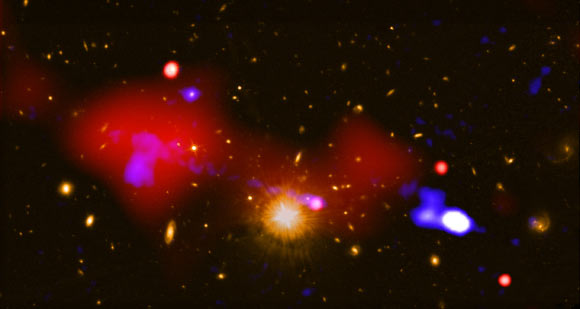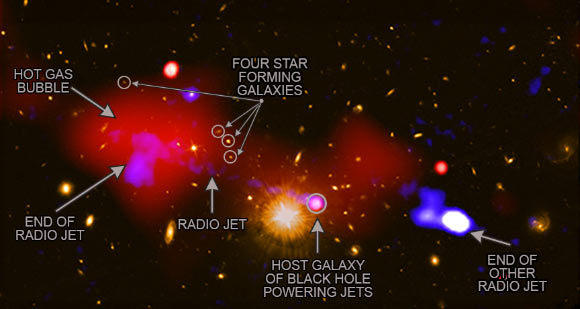Supermassive Black Hole Triggers Star Formation in Multiple Galaxies | Astronomy – Sci-News.com
Enormous black holes usually affect their surroundings through the so-called ‘negative feedback’ — in other words, suppressing the formation of new stars. This can occur when the black hole’s jets inject so much energy into the hot gas of a galaxy, or a galaxy cluster, that the gas can’t cool down enough to make large numbers of stars. In a newly-discovered group of galaxies, astronomers have found a less common example of ‘positive feedback,’ where a supermassive black hole enhances star formation in several members of the galaxy group, and over a distance of about one million light-years. The discovery, described in the journal Astronomy & Astrophysics, was made using NASA’s Chandra X-ray Observatory.

This composite image shows the surroundings of a supermassive black hole that is triggering star formation across the longest distance ever seen; as hot gas swirls around the black hole, it emits large amounts of X-rays that Chandra detects; the black hole is also the source of radio-wave emission from a jet of high-energy particles — previously detected by scientists with the VLA — that stretches about a million light-years. Image credit: NASA / CXC / INAF / R. Gilli et al / NRAO / VLA / STScI.
“This is the first time we’ve seen a single black hole boosts star birth in more than one galaxy at a time,” said Dr. Roberto Gilli, an astronomer in the National Institute of Astrophysics.
“It’s amazing to think one galaxy’s black hole can have a say in what happens in other galaxies millions of trillions of miles away.”
The newly-discovered supermassive black hole has a mass of about 32 million solar masses and is located in the center of a galaxy about 9.9 billion light-years from Earth.
The host galaxy has at least seven neighboring galaxies, according to observations with ESO’s Large Telescope (VLT) and the Large Binocular Telescope (LBT).
Using NSF’s Karl Jansky Very Large Array, astronomers had previously detected radio-wave emission from a jet of high-energy particles that is about a million light-years long.
The jet can be traced back to the supermassive black hole, which NASA’s Chandra X-ray Observatory detected as a powerful source of X-rays produced by hot gas swirling around the black hole.

An annotated version of the image. Image credit: NASA / CXC / INAF / R. Gilli et al / NRAO / VLA / STScI.
Chandra also detected a diffuse cloud of X-ray emission surrounding one end of the radio jet.
This X-ray emission is most likely from a gigantic bubble of hot gas heated by the interaction of the energetic particles in the radio jet with surrounding matter.
As the hot bubble expanded and swept through four neighboring galaxies, it could have created a shock wave that compressed cool gas in the galaxies, causing stars to form.
All four galaxies are approximately the same distance, about 400,000 light-years, from the center of the bubble.
Dr. Gilli and colleagues estimate that the star formation rate is between 2 and 5 times higher than typical galaxies with similar masses and distance from Earth.
“By targeting objects similar to this one, we may discover that positive feedback is very common in the formation of groups and clusters of galaxies,” said Dr. Colin Norman, from the Johns Hopkins University.
_____
R. Gilli et al. 2019. Discovery of a galaxy overdensity around a powerful, heavily obscured FRII radio galaxy at z = 1.7: star formation promoted by large-scale AGN feedback? A&A 632, A26; doi: 10.1051/0004-6361/201936121






